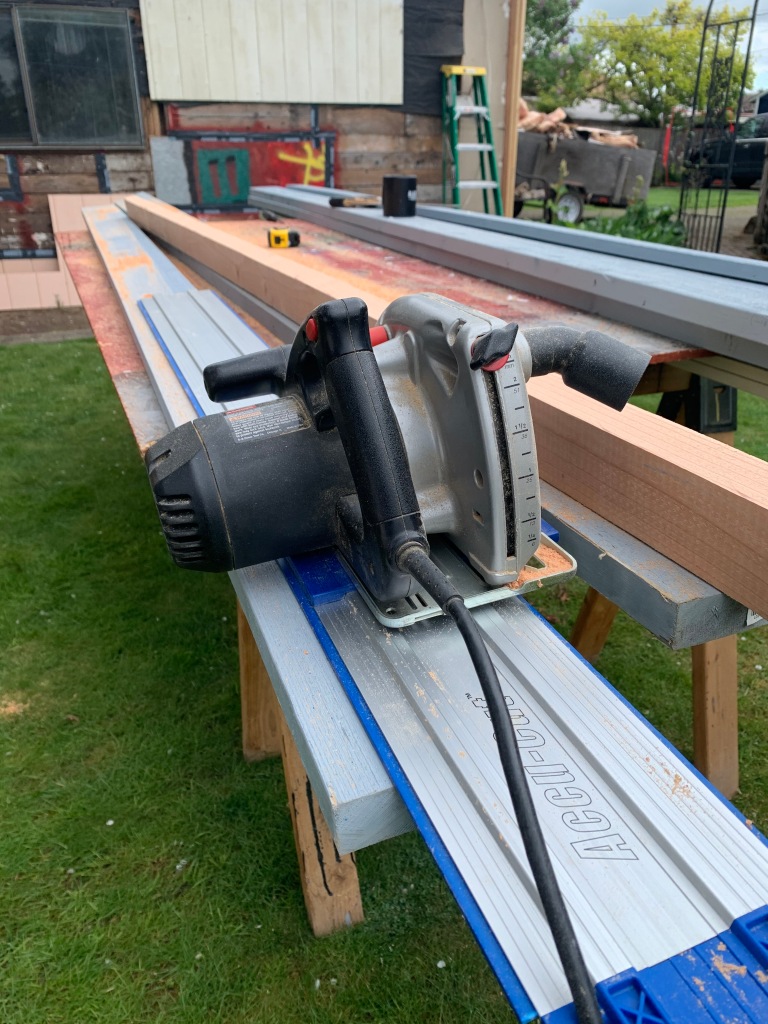I have added some new products to my shop/tool stable to work on my latest project. One of them is the Kreg Accu-cut fence system to turn your ordinary circular saw to a more precise track saw.
The reason that I considered this option is that I wanted to make some angled cuts on 10′ long lumber. I could do it on the table saw, but I would have to be really careful as my shop is only 24′ in length. I would usually open the door to make sure I had extra length (with counter space). Also, I have some sheet goods to cut.
If you have ever priced one of these units, you would see why the Kreg system is so appealing. I saw entry levels around $400 and the high end at $1000. You supply the saw, so you can use your everyday circular saw which means that you don’t have to own a specific use tool.
The theory is that the saw rides on a track to create a straight cut. I have heard of cases where table saws have been replaced for track saws. I often times use a circular saw to break down sheet goods when working on projects because they are so much easier to handle. So, I thought this might be a good solution.
The setup was a little tricky. I usually read the instructions, especially when there are lots of small parts and screws. There were some errors in the instructions like diagram labels not matching the written text which left me guessing at times.
Getting everything indexed and aligned was a little bit fiddly. The saw had to be moved on the carriage, so as not to cut the rubber bumpers (edge). I also tried to get the saw as close to the bumpers as possible so I could plop the track down on the line and know where to cut, but it is about a sawblade off. I suppose when you make something ‘universal’, you have to leave margin for every saw possibility.
The carriage seems a little flimsy made of plastic and the hold down of the saw a bit tenuous with two pointed screws holding the saw into place. When on the track there was a bit of side to side play. There is not a real good feeling of positive connection when the saw is on the track. What I can say is that none of those things caused a problem for my cuts.
The track has a sticky back and a rear stop, so it stays in place pretty well with friction and forward pressure. You do have to watch to make sure the front is not moving away from the line as you cut. This is remedied by watching the track ahead, not the saw. If you want to make a cut longer than 50″, you need to stop, remove the rear stop, slide the whole track back before cutting again.
By far and away, the biggest downside to this product is the screws that hold the track together back out with use. I saw a lot of complaints about this on the internet, After using it yesterday, I put some thread locker on the screws.
| Score | Pros | Cons | |
|---|---|---|---|
| Value | 4/5 | Compare to other track saws the cost of $80 vs $450-1000 | A 50″ track is not long enough to rip a full sheet of plywood |
| Allows the use of one circular saw to be more precise | Adding tracks are expensive. If I used routinely, I would have an 4′ and a 8′ track ($160) | ||
| Quality | 3/5 | The sled glides nicely on the track | The set screws holding the track together, tend to back out with used |
| The friction pads hold the track on the wood without clamps | Saws with a thick base plate do not mount securely | ||
| The setup instructions had some errors that were not totally intuitive | |||
| Performance | 4/5 | I got nice results on cutting panels in half, tapers and ripping lumber | Everything was as advertised, I just didn’t do enough research on this before purchasing. I think full panel cutting capability would be better. |
The bottom line, this is a worthy product for someone like me. I have three electrical circular saws already, I sometimes cut sheet goods and accuracy is important. If I were a professional using a track saw, I would most likely consider a more expensive option for durability reasons. I really wish that I could rip an entire sheet of plywood easily, extra track lengths are available for purchase at $80/4′.
I will continue to use this because I like the results that I got and I don’t regret the purchase.


Recent Comments